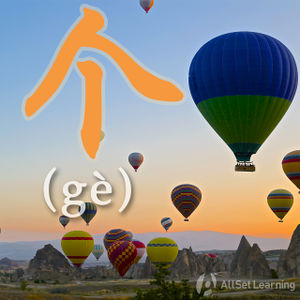Difference between revisions of "Measure word "ge""
ViktorMugli (talk | contribs) |
|||
| Line 14: | Line 14: | ||
You can specify the quantity of any noun with this structure. Note that any time you want to state ''how many'' of a noun in Chinese, you probably need a measure word. First get used to doing it with 个. | You can specify the quantity of any noun with this structure. Note that any time you want to state ''how many'' of a noun in Chinese, you probably need a measure word. First get used to doing it with 个. | ||
| − | + | == Examples == | |
<div class="liju"> | <div class="liju"> | ||
Revision as of 06:27, 10 August 2012
-
Level
-
Similar to
-
Used for
-
Keywords
The measure word 个 (ge) is the most common measure word. It can be used for any noun if you can't think of a more precise measure word. Also, for many nouns, 个 is the correct measure word.
Contents
General structure
The general structure for 个 (and measure words in general) is:
Number + 个 + Noun
You can specify the quantity of any noun with this structure. Note that any time you want to state how many of a noun in Chinese, you probably need a measure word. First get used to doing it with 个.
Examples
- 一 个 人
- 两 个 人
- 三 个 苹果
- 一 个 三明治
- 八十 个 诗人
Omitting the number
If the number is one (1), you can omit it and use 个 by itself. This is equivalent to a or an in English, for example in "a person" or "an idiot."
Some examples of that:
- 他 是 个 好人。
- 那 不 是 个 苹果。
- 我 是 个 英国人。
See also
- Counting money
- Measure words in quantity questions
- Measure words for counting
- Measure words to differentiate
Sources and further reading
Books
- Chinese: An Essential Grammar, Second Edition (pp. 21-2) →buy
- Integrated Chinese: Level 1, Part 1 (3rd ed) (pp. 45-6) →buy
Websites
- Chinese classifier (Wikipedia)



